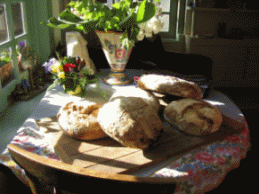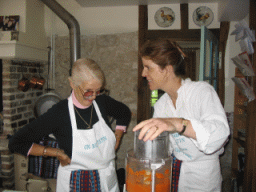On Rue Tatin

- SUBSCRIBE
- ALREADY SUBSCRIBED?
BECOME A BONJOUR PARIS MEMBER
Gain full access to our collection of over 5,000 articles and bring the City of Light into your life. Just 60 USD per year.
Find out why you should become a member here.
Sign in
Fill in your credentials below.
 Chef and author Susan Herrmann Loomis has been up since 6:30 AM, not too long after the roosters in France cry “cocorico” and the first cars of the morning circle around le rond point in the center of the small Norman town of Louviers. She has already made a loaf of homemade sourdough bread this morning, using a special starter recipe from a farm in the Dordogne, and done the legwork for an entire day of cooking. All things being equal, one would never guess that this mother of two, trained at La Varenne Ecole de Cuisine and a bona fide expert in French culinary tradition, hailed from anywhere other than France.
Chef and author Susan Herrmann Loomis has been up since 6:30 AM, not too long after the roosters in France cry “cocorico” and the first cars of the morning circle around le rond point in the center of the small Norman town of Louviers. She has already made a loaf of homemade sourdough bread this morning, using a special starter recipe from a farm in the Dordogne, and done the legwork for an entire day of cooking. All things being equal, one would never guess that this mother of two, trained at La Varenne Ecole de Cuisine and a bona fide expert in French culinary tradition, hailed from anywhere other than France.
However, the six cookbooks and two memoirs about her life in France–an output reeking of American productivity—give away her American nationality. Then there’s the steady stream of Americans booking themselves into the few hotels in Louviers, lending it a sort of metropolitan diversity (someone put in an international airport!). They have come to participate in the culinary school Loomis began four years ago, On Rue Tatin.
 The cooking students, myself included, had arrived for the beginning of class two nights before at the beautiful restored old convent located on Rue Tatin that Loomis calls home. We whetted our appetites with an assortment of amuse-gueule: Radis à la Fleur de Sel (radishes with butter and sea salt) and pistachios, admiring the eleventh-century Catholic church of Louviers, in back of us, and Susan’s home, facing us.
The cooking students, myself included, had arrived for the beginning of class two nights before at the beautiful restored old convent located on Rue Tatin that Loomis calls home. We whetted our appetites with an assortment of amuse-gueule: Radis à la Fleur de Sel (radishes with butter and sea salt) and pistachios, admiring the eleventh-century Catholic church of Louviers, in back of us, and Susan’s home, facing us.
“What made me think about doing a cooking school was how people reacted when they visited our house,” says Loomis, whose husband, Michael, is a sculptor and renovated the house himself. When they first purchased it in 1993 it was nearly in ruins, but they were nonetheless charmed by its storied past as a convent for nuns. Over several years, Michael transformed it room by room. Now, Loomis fills the kitchen, which comfortably fits six to eight, with students ten weeks per year for six days at a time during her cooking courses.
 Nervous about my own culinary competencies I was hoping to hunker in a corner, hiding in a voluminous apron during the cooking portions, but Loomis assigns recipes to everyone. Less experienced cooks begin with something simple like a vinaigrette, while more experienced students skin a fish or cleave the head off of a rabbit for the delicious Lapin aux Légumes Printaniers, a rabbit dish with spring vegetables.
Nervous about my own culinary competencies I was hoping to hunker in a corner, hiding in a voluminous apron during the cooking portions, but Loomis assigns recipes to everyone. Less experienced cooks begin with something simple like a vinaigrette, while more experienced students skin a fish or cleave the head off of a rabbit for the delicious Lapin aux Légumes Printaniers, a rabbit dish with spring vegetables.
Loomis dishes out advice as we go. “A fish-fillet knife is great for cutting shallots,” she says as I struggle with a large knife. Or of the kitchen etiquette variety: “It’s generally not a good idea to wear open-toed sandals while cooking,” and she eyes a display of sharpened knives on the countertop and looks at my exposed toes.
Blue flames flare up from the burners of the gas stove, while students bearing blades slice fresh garlic, mince onions, and dice rhubarb. As the Cuisinart food processors hum while blending bread dough, Loomis relates the changes in her food philosophy over the years. “I was once a romantic,” she says while explaining how she used to make bread completely by hand. “But I’m over that,” she laughs, putting the dough in the blender.
 At lunchtime, senses heighten and everyone retires to the dining room, where family heirloom candelabra decorate the walls and burgundy-colored curtains frame the windows. Loomis is detail-oriented and the minutiae are not lost on the guests, who comment on the tablecloth changes, garnishes on the dishes, and perfect positioning of utensils. In typical French style, we eat several courses over a few hours peppered with conversation, usually guided by Loomis. “One of my favorite parts of the classes is having a captive audience,” she says.
At lunchtime, senses heighten and everyone retires to the dining room, where family heirloom candelabra decorate the walls and burgundy-colored curtains frame the windows. Loomis is detail-oriented and the minutiae are not lost on the guests, who comment on the tablecloth changes, garnishes on the dishes, and perfect positioning of utensils. In typical French style, we eat several courses over a few hours peppered with conversation, usually guided by Loomis. “One of my favorite parts of the classes is having a captive audience,” she says.
If the students of her first class of On Rue Tatin were less than attentive, it’s because they weren’t there. The opening course of On Rue Tatin was slated for the week of September 11, 2001. All of the enrolled students cancelled. The subsequent week, three of seven came as planned.
Now cruising into her fourth year, Loomis fills the sessions regularly but realizes she has taken the market on at a tough time. “There couldn’t have been more unforeseen obstacles,” she says. “From 9/11 to the war in Iraq to the ‘We hate France’ phenomenon and now the weak dollar.” But she still regularly fills the classes she presides over throughout the year.
 On Wednesday Loomis takes us to Le Neubourg, a nearby town to gather food for a picnic lunch. Her instructions are, “Get what your spirit moves you to get.” I come back with goose eggs and rillettes with a little help from a friend. These field trips, along with invited guests and short demonstrations, provide for a varied program. On Monday there’s a salt tasting and a visit from a goat cheese producer, Tuesday, an olive oil tasting and a visit to a regional artist’s studio. On Wednesday night, a local wine expert leads a dégustation de vin (wine tasting). These diverse glimpses into the culinary world provide students with a richer experience than had they simply followed a recipe. Knowing where an ingredient comes from or how it’s made is as important as knowing how to cook it.
On Wednesday Loomis takes us to Le Neubourg, a nearby town to gather food for a picnic lunch. Her instructions are, “Get what your spirit moves you to get.” I come back with goose eggs and rillettes with a little help from a friend. These field trips, along with invited guests and short demonstrations, provide for a varied program. On Monday there’s a salt tasting and a visit from a goat cheese producer, Tuesday, an olive oil tasting and a visit to a regional artist’s studio. On Wednesday night, a local wine expert leads a dégustation de vin (wine tasting). These diverse glimpses into the culinary world provide students with a richer experience than had they simply followed a recipe. Knowing where an ingredient comes from or how it’s made is as important as knowing how to cook it.
“I love transforming the way people think about food,” Loomis says. And she does exactly this. By the time I left On Rue Tatin, I was ready to violently oust canned and frozen vegetables from my kitchen in favor of their fresh kin. Today, I found myself stopping at a local épicerie to examine a crate-full of apples. A tad too wrinkly to eat from the hand, but they could make a wonderful tarte tatin.
For information about how to sign up for classesm go to the On Rue Tatin website: http://www.onruetatin.com or call +1.415.474.9104
Prices for classes are:
2,000 euros for a six-day course
Special classes are 2,300 euros
Apple course is 2,400 euros
Three-day wine course is 1,800 euros
Classes are exclusive of lodging and transportation.


